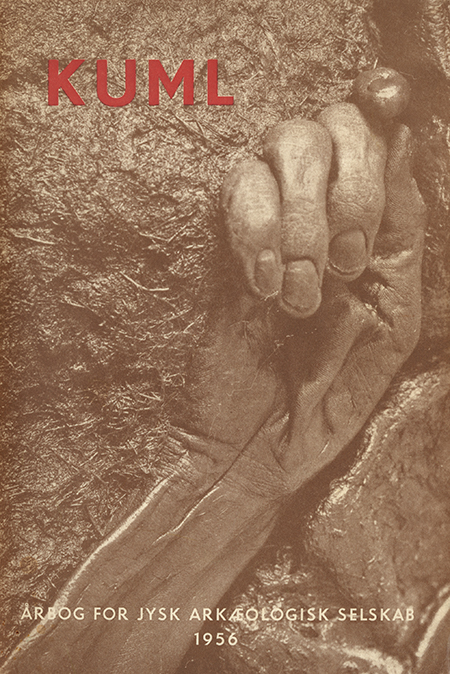Afsked med ådalen
DOI:
https://doi.org/10.7146/kuml.v6i6.97285Keywords:
Illerup, Illerup ådal, Weapon offer, våben offerAbstract
The Weapons in the Illerup Valley. The Glose of Seven Years' Excavation
The Illerup Valley discovery (near Skanderborg to the southwest of Aarhus) was made in May 1950. Since then excavations have gone on every year in the valley. The objects found comprise weapons, which with high probability may be interpreted as booty of war, deposited in the peat bog as a thank offering to some divinity for success in battle. The date of the offering (or offerings) is the centuries immediately following the commencement of the Christian Era. The background to the discovery is probably that of inter-Scandinavian tribal wars. The discovery has been described in KUML 1951. There follows here a short account of what has happened since then.
It has been determined that the objects found were not deposited on one single occasion; they are the results of several offerings, taking place at different points of time. The grouping of the objects, together with the distribution of the types of artifacts, enables three, perhaps four, separate sites to be distinguished. Two large sites (Nos. 1 and 2) lie clearly separated from each other. In the case of site 1 the destruction to which practically all the objects from the lllerup discovery have been subjected has been crowned by burning. This burning is doubtless the reason why objects of wood are practically never found on this site. On site 2 objects of wood occur, though in no particularly large quantities.
Site 3 was smaller than the first two sites. It consisted of two small but rich groups of artifacts which Jay apart from each other but without doubt represent a single deposit. The somewhat conjectural site 4 consisted of a little group of objects of wood which lay in the area of site 2 but at a somewhat higher level. These objects of wood do not appear to be associated with any of the other sites; they probably belong to a separate deposit, of which the other items have not yet been located.
The artifacts on the two larger sites (1 and 2) must certainly have been thrown out from the shore of the bog - or lake, as it was at the time of deposition. On both sites the objects lie thickest nearest the shore, and diminish in numbers further out. In the case of site 3 the possibility exists that the objects were deposited from a boat or laid out on ice.
How the area was marked out, to make it possible for the place formerly used to be found again at the time of new offerings, is uncertain. A number of posts set in the ground have been found scattered over the area, and these may have been visible above the surface of the water.
The total number of artifacts discovered - including fragments - amounts to about 1240. In addition there are over 600 objects which cannot be classed as regular artifacts: ground-set posts, logs and branches showing axe-marks, axe-chips, animal bones and charcoal. As many of the artifacts discovered are in fragments it is difficult to give any summary of the totals of the various artifact types found. The number of swords must exceed a hundred, and the number of shields is about the same. About 270 complete spearheads have been found; as well as a number of fragments. Fragments of spear-shafts occur in large numbers. A single spearhead had its shaft preserved to almost its full length (1.89 metres). Arrowheads amount to about 150 complete and a number of fragments. Arrow-shafts were rare. In addition a large number of knives were found, as well as fitments of various types in iron and bronze. Among the objects less commonly found on the sites may be named: axes, awls, combs, razors, tweezers, spurs, steel and stone for firelighting, and a single scythe. In addition: buckles and buttons, fibulae and a gilt bronze armlet. Only sherds of pottery vessels survived, of wooden vessels one single complete specimen and a number of fragments. Decoration and ornamentation is only rarely found on the objects, but does occur, for example on combs, chapes, knives and fitments. Occasionally inlay of precious metal is found on swords and spearheads, while one sword pommel bears animal heads.
Among the larger objects found may be mentioned a dugout boat and the skeletons of two horses. The horses had been poleaxed and their eyes gouged out, and they bore in addition the marks of numerous stabs.
Included among the objects discovered are 19 Roman coins, clearly deposited in a single group belonging to site 3. They range in date from Nero to Commodus, the latest coin in the collection being dateable to 183 AD.
The objects discovered on sites 1, 2 & 3 would appear to have been deposited in the 3rd and 4th centuries AD. No estimate can be made of the age of the somewhat uncertain site 4.
The fruits of the excavation are now to be found at the Prehistoric Museum in Aarhus. A portion of them will later be transferred to Skanderborg Museum.
Harald Andersen
Downloads
Published
How to Cite
Issue
Section
License
Fra og med årgang 2022 er artikler udgivet i Kuml med en licens fra Creative Commons (CC BY-NC-SA 4.0).
Alle tidligere årgange af tidsskriftet er ikke udgivet med en licens fra Creative Commons.


